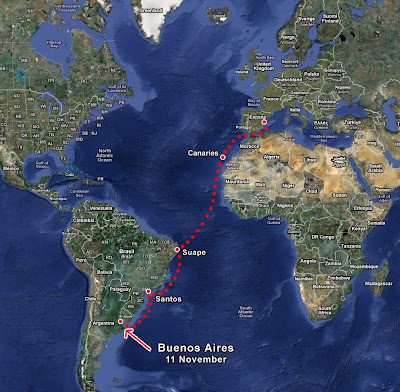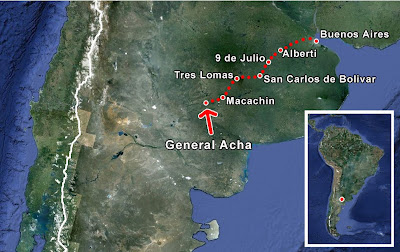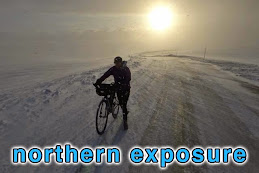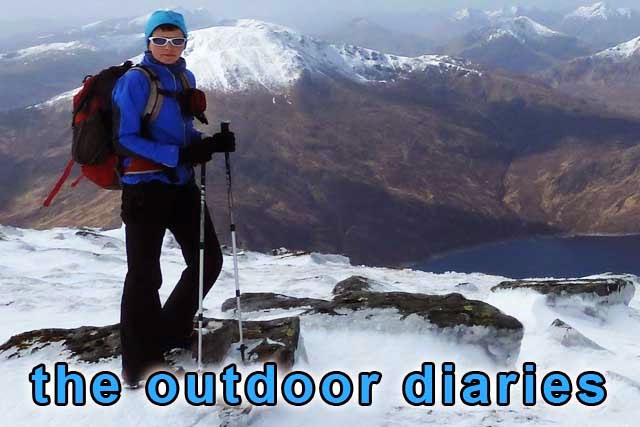
Well that´s all the naff nautical puns over and done with at the start. I do have a lot to tell you though. I´ll just start at the beginning, back in Valencia. A pleasant cycle took me from my hotel to the cargo terminal at the port where I was to join my ship. Because of safety and security concerns, I couldn´t simply just cycle up to the ship. Shirley and I were packed onto a minibus and driven across the port through a vast sea of multi-coloured containers and passed gargantuan ships being loaded and unloaded by enormous cranes. Everything in the cargo terminal is made on a massive scale and could feature in that TV programme "Big, Bigger, Biggest". I spotted the cargo ship that would take me across the Atlantic to South America, the giant letters on the hull spelling out her name, MSC Lausanne. She was reassuringly gigantic!
Pulling up to the ship I felt really excited about the voyage ahead - it just sounded so adventurous and romantic to cross the ocean on a proper noisy, dirty, working ship and not a namby-pamby cruise-liner. I was relieved to be at the gangway at last - I´d booked my passage months ago, one of the first steps in pulling my world cycle together. But there had been so many changes that I´d wondered if it would ever happen. I was just a tiny bit apprehensive - would I be sea-sick; would I even like being on a ship for nearly 3 weeks; would it be frightening if we ran into a storm, or even if we didn´t?
I´d no sooner been deposited at the gangway when a flurry of friendly Philippino crewmen hoisted Shirely and my bags on board. I was issued with my security pass for the ship which designated my rank as "supernummery" ie passenger. Then I was left to settle into my cabin. I hadn´t known what to expect for accommodation on board but certainly not the luxury I was landed with. My cabin had a spacious lounge, a double bedroom with ensuite bathroom and a cracking view to the front of the ship. If Lausanne was the Titanic, I would be in First Class with Kate Winslet. My lounge had comfy sofas and a large table where I could lay out my maps, pretending I was the captain plotting a course through rough, pirated seas. Talking of the captain, he was ruggedly handsome and I swooned in his presence, though it may just have been the motion of the ship.
The ranks "captain" and "master" mean the same thing and on this ship the crew call him "the master", a term which I always find a bit kinky.
There were three other passengers hitching a ride on Lausanne. On freighters the priority is always the cargo so most can only carry about four to six passengers in whatever cabins are not needed for crew. My fellow travellers were Dutch - very nice people who shared my interest in staring at the sea. Emile and Ellen were excellent bird-spotters and Harko had a wicked sense of humour. There are no special facilities on board for passengers - everything is shared with the crew including meals which fitted around the schedule of watches. Three substantial meals were served each day and lunch always included a piece of fruit so we didn´t get scurvy. There was also freshly-brewed coffee in the morning and afternoon - it´s a hard life at sea!
With no leisure activities provided, some people might find travelling by freighter boring but it suited me perfectly - no crowds, no noise, no traffic - just peace and the ocean. And there was always something to see. Our first exciting landmark was leaving the Mediterranean and entering the Atlantic through the Straits of Gibraltar. I didn´t know it was so narrow you can see Africa and Europe at the same time.

The other main difference to a cruise is that passengers on a freighter are, with a few restrictions, able to go anywhere on the ship and this makes the experience so unique. I could go onto the bridge anytime, walk right round the main deck below the skyscraper stacks of containers (a round circuit of more than half a kilometre), climb up to the monkey island (the topmost deck above the bridge) or chill out in one of my favourite places on the ship, the fo´csle. The fo´csle is the most forward below-decks area of the ship and it´s here that you can peer down into the shafts that house the giant, rusty anchors and run your hands along the massive chains that they drop on, each link a foot wide. You can stick your face into the port holes at the very front of the ship for that "windswept and interesting" look and the water seems close enough to trail a hand through.
As the fo´csle is the farthest away point from the engine, it´s also quite quiet here - you can hear the waves, the wind and the plop of the flying fish on re-entry.
Most days I also visited the bridge, the command centre of the ship, to get an update on position and weather, and for the best seat in the house. There is a Starship Enterprise-style control desk with big leather chairs and a dashboard with switches, levers and radar screens. Rows of computers and printers collate information from the weather forecast to the layout of the containers, as well as the multitude of navigational data. Despite all the technology, the ship´s course is still plotted on paper charts and a hard copy log book is maintained. Experienced nautical types (like myself) know that the term "bridge" comes from the 19th century when the structure was much like a footbridge slung across the width of the ship. And Captain Kirk would tell you that "log book" originated in the early days of sailing when the ship´s records were written on wooden shingles that were then hinged together like a book.
Of course, there was the excitement of arriving in some exotic, foreign port, especially so if it was at night, as was the case in Las Palmas in the Canaries and Santos in Brazil. The approach to Santos was particularly memorable. The docks are located some way up the narrow Santos Channel and after spending two days at anchor several miles out, we got the go ahead to enter the docks at 4am. It´s not difficult to get yourself up at that time if you want to watch the ship berth because whenever the engine is started the entire superstructure shakes violently as if there is an earthquake. As we sailed up the channel, the skyscrapers of Santos were on the port side - they seemed so close and I was so high up on the bridge, that I felt I could almost peer into the windows. For the approach all the lights on the bridge were switched off, adding to the blackness of the night.
There was an air of excitement and suspense as our Leviathan ship was coaxed gently up the channel and into her berth under the cover of darkness. You could hear a pin drop or a flying fish plop.

When the ship is in port you can watch the comings and goings of other big ships or the loading and unloading of containers - thousands of identical metal boxes are moved around the port, put onto ships and taken off ships. Some global logistics nerd has a handle on what it all is and where it´s all going. It may surprise you to know that only the bottom row of containers is actually strapped to the ship - the rest just stack and click together like giant pieces of Lego.
The ship never really sleeps. In port loading and unloading go on through the night as necessary. Once she´s left port, the ship ploughs on without pause across the seas - through the dazzling brightness of day and the inky blackness of night, under a hot tropical sun or a sky full of stars. In this way, it took us five days to cross the Atlantic from the Canaries to Brazil.
I, on the other hand, did sleep ... very well. Though it was a little unnerving at first going to bed on the ship. Unlike cruise ships, freighters aren´t fitted with stabilisers so there is a surprising amount of roll on even a calm sea. You seem to notice it more at night, along with the deep rumble of the engine and the constant creak of the superstructure. But I got used to it quite quickly, along with moving up and down the external stairs which I found mildly terrifying at first - it just seemed so easy to fall overboard.
A lot of time onboard I spent sitting out on deck watching the waves, the weather and the wildlife. The day we sailed between the Cape Verde Islands and the African coast we ran into a pocket of hot, humid air that deposited a cloud of insects on the ship - cicadas about two inches long, colourful beetles, giant grasshoppers and even a dragonfly. It was slightly surreal to hear the dusk-time chirrupping of cicadas in the middle of the ocean. It was even more surreal the following evening to hear karaoke belting out across the waves as the crew enjoyed a night off.
The first morning I woke up in the Southern Hemisphere, I threw back the curtains to see a flock of boobies circling the ship. Boobies are handsome, black and white, gannet-like birds. I rushed up to the bridge where they hung on the breeze at eye level before folding themselves into dart shapes and diving into the sea for fish. I could even follow their progress underwater by the trails of aquamarine bubbles. High above the boobies there hung a dark, menacing shape - a figgate bird. It´s a pirate and steals the catch from the boobies by harrassing them until they drop it.
But the most special wildlife encounter happened as we sailed down the coast of Brazil. The morning had been grey with heavy rain but it cleared up to a calm, bright afternoon. A humpback whale was spotted on the port side and then one on the starboard side and then another and another until all around the ship there were whales. Whales breaching with an explosion of white foam or giant flukes slipping into the deep with barely a ripple. As the sun sank, the evening rays turned the blasts of spray from the whales´ blowholes into golden mists that hung above the waves before dispersing on the breeze.
Mostly the weather on the voyage was calm and sunny, though there were some days with rain and it was quite rough sailing thourgh the Straits of Gibraltar. Approaching Santos on the east coast of Brazil, we sailed into an electrical storm on an enormous scale. Jagged forks of lightning cracked across the night sky, sometimes blinding silver and sometimes with an edge of orange glow. With each flash the ocean for 20 miles around was turned from night to day. It would have been a beautiful spectacle anywhere but to watch it from the bridge of a big ship in the middle of the ocean was spectacular.

I´d really, really hoped for a big, wild storm on the voyage ... and I wasn´t disappointed though I had to wait until the last couple of days before we ran into a Force 8 storm. It had been a calm, clear day but later in the afternoon a strange line of dark cloud appeared across the horizon, stretching for about 15 miles. Then it started to evolve in the weirdest way - below the line the sky turned almost black but above the line an enormous wall of cloud built up with a surface like bubble-wrap and a tint of pink. As we sailed into this, I was out on the bridge deck and suddenly the wind blew up from nowhere, 0 to 60mph, calm to gale force, in about 2 seconds. I rushed inside the bridge as torential rain now joined the wind in battering the ship. The sea was all heaped up with a surface like meringue and streaked with foam.
Visbility was so bad we could barely see the front of the ship. I watched this, transfixed, on the bridge. I´d wondered if being in a storm at sea would be frightening but it wasn´t - it was obvious that a Force 8 storm was nothing to a ship of this size and Lausanne the Leviathan plodded on through it all.
At 09.30 on 11 November, 19 days after leaving Valencia, MSC Lausanne berthed in Buenos Aires, Argentina and my cargo ship adventure was over. I´d had a brillaint journey and a unique experience and was quite sad to say goodbye to the old girl. The cargo ship adventure may be over but a new adventure begins as I set out to cycle through South America over the next few months. If I can find my way out of the chaos of Buenos Aires that is!
The question that people always asked me when they learned that I would be travelling by freighter was "what will the cargo be?" I´m afraid I don´t know what Lausanne was carrying across the Atlantic (not even the captain knows what´s in the containers) but, if you look carefully, there may be a clue in my Flickr photos.














